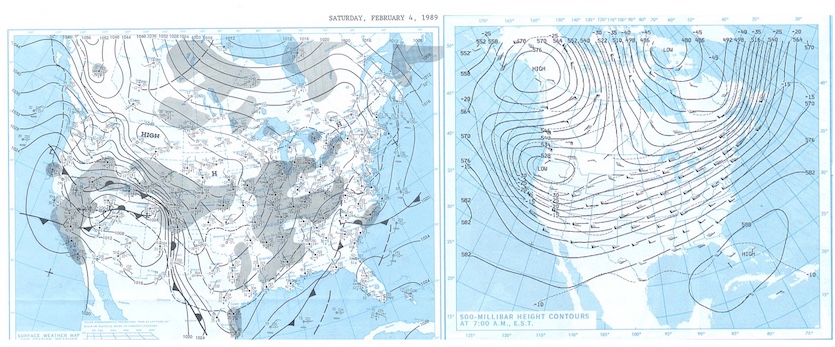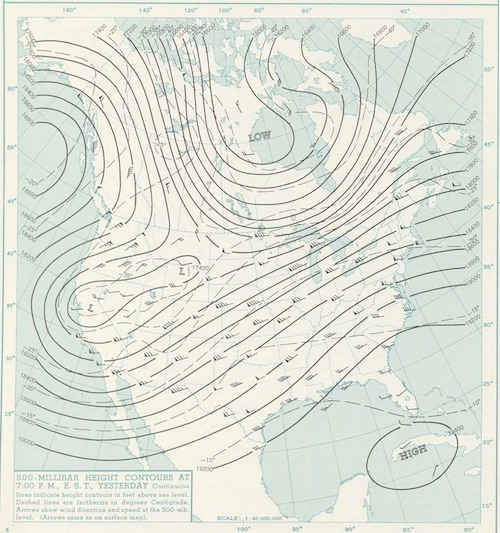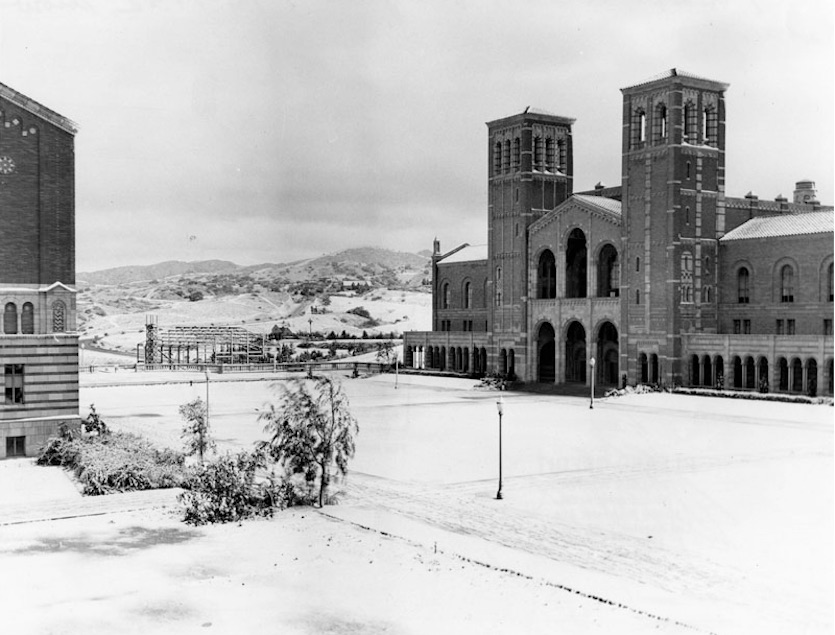Above: An aerial view of the Golden Gate Bridge and Marin Headlands covered in snow right down to sea level on Feb. 7, 1976—the last time measurable snow fell at sea level in the San Francisco Bay Area. Image credit: Courtesy of Art Frisch, San Francisco Chronicle.
A strong flow of cold air filtered over California on February 18-21, 2018, prompting the National Weather Service to issue rare snow advisories for coastal portions of the state, even saying that “snowflakes in the air may be possible at sea level”. Due to a lack of moisture with the system, the expected snowfall at sea level never materialized (although non-accumulating snow fell at Eureka for an hour on the evening of February 18).
So just how rare is accumulating snowfall at sea level in California? In fact, snowfall at sea level locations in California is even more rare than snowfall along the U.S. Gulf Coast (aside from coastal Florida). In the climate of the past several decades, one can expect to see snowfall somewhere along the U.S. Gulf Coast about once every five years. The return rate for snowfall at sea level in central and southern California is probably more like once every 20 years, and that span appears to be getting larger (see below).
The synoptic (large-scale) situation usually in place when snow does fall at sea level in California is a powerful upper-level low sliding down the U.S. West Coast and retrograding just far enough offshore to enhance the flow of moisture from the Pacific inland and atop the low-level cold air. Figures 1 and 2 show an example of these surface and upper-level features in early February 1989. This storm resulted in the heaviest sea-level snow event in modern California history, with the coastal town of Klamath (18 miles south of Crescent City) picking up an astonishing 19.5” of snow on February 3-4, with a maximum depth of 8”.
 |
| Figures 1 and 2. Surface (left) and upper-level (right) weather maps valid at 12Z (7 am EST) February 4, 1989. The upper-level map shows the height (in decameters) of the 500-millibar pressure surface . Note that Eureka is reporting snow showers at this time (4 am PST) and that a 1056-mb surface high pressure dome sits over British Columbia. This is the type of scenario that can bring coastal snowfall to northern and central California. Image credit: NOAA/NWS. |
 |
| Figure 3. The 500-mb map valid at 0Z (4 pm PST) January 21, 1962, the last time that snow fell in downtown Los Angeles. This rare configuration is the type one might expect to see in association with snow falling at sea level in southern California. The 500-millibar heights are shown here in feet rather than decameters. Image credit: NOAA/NWS. |
The records
Below is a list of the greatest single snowfall events for sites along the coastline (or bays) of California. All locations are at or below 100 meters in elevation (about 330 feet). The periods of record vary for all the sites, but all go back at least 75 years. Because measuring snow accurately can be a challenge even where snow is a frequent occurence, the veracity of the reports for some of the lesser-known locations is open to question, although the figures do appear on the official COOP forms as submitted by local weather observers. The list is arranged geographically from north to south.
 |
| Figure 4. Table of single-storm record snowfall events for selected locations along the coast of California (or near sea level in the case of Berkeley). |
Of course, snowfall in the coastal mountain ranges above 1500 – 2000 feet is almost an annual occurrence. What IS rare is snowfall at sea level, even in northern California.
Los Angeles
Needless to say, the snow history for both Los Angeles and San Francisco is quite detailed, with plenty of photographic and anecdotal evidence.
The biggest L.A. snowstorm in official records occurred on Jan. 19-20, 1949. A series of intense cold waves swept across the entire West during that month, with most sites in California, Nevada, Oregon, and Idaho experiencing their coldest month on record. Not only did it snow (twice!) in southern California that month, but Las Vegas picked up an amazing 16.7” of snow.
 |
| Figure 5. A rare color photo of the snowstorm of January 19-20, 1949, in the Monterey Park community of San Gabriel (elevation about 750 feet). The three inches of “snowfall” reported in downtown L.A. was actually mostly graupel, or soft ice pellets produced by intense updrafts in relatively cold air. Image credit: Courtesy of the Monterey Park History Collection, Monterey Park Bruggemeyer Library. |
Another famous month for cold and snow in coastal Southern California was January 1932. Los Angeles picked up an official 2.0” of snowfall on January 15. Curiously, December of the same year also brought record snowfall to portions of California, including coastal sites such as Big Sur and Fort Ross well north of Los Angeles. Bakersfield, in the southern end of the San Joaquin Valley, experienced its all-time greatest snowfall of 4.0” on Dec. 11, 1932.
Climatologist Maximiliano Herrera notes that snowfall occurred in Los Angeles in 1882 (when snow was also reported in San Diego), January 1922, and February 1937.
 |
| Figure 6. The campus of the University of California, Los Angeles, was blanketed under a couple of inches of snowfall following the storm of Jan. 15, 1932. Note how the campus appears to practically be in the countryside at this time! Image credit: Courtesy of the Security Pacific National Bank Collection, Los Angeles Public Library. |
San Francisco
Not surprisingly, San Francisco has experienced more snowy days than Los Angeles, although most of the city’s greatest snowfalls occurred in a relatively short period—the 1880s and 1890s. Here is a list of those accumulating snows during those two decades:
3.5” on Dec. 31, 1882
1.5”-2.0” on Feb. 7, 1884
3.7” on Feb. 5, 1887 (the city’s greatest snowfall, with 7” reported in the western part of the city)
0.1” on Jan. 16, 1888
1.0” on March 3, 1896
Since 1900, there have been only two official reports of accumulating snow in downtown San Francisco: Dec. 11, 1932 (0.8”) and Jan. 15, 1952 (0.3”). However, photographic and anecdotal evidence shows that measurable snow fell at low elevations in the city on Feb. 28, 1951, Jan. 21, 1962, and Feb. 7, 1976. Mr. Herrera notes that accumulating snow was reported in downtown San Francisco in 1858 as well.
Peter Hartlaub put together an excellent recap of San Francisco snow events, published by the San Francisco Chronicle in 2011.
 |
| Figure 7. A rare photograph of San Francisco’s greatest snowstorm in progress on Feb. 5, 1887. An official total of 3.7” was reported downtown, with up to 7” in the hills west of the city center. Image credit: San Francisco Chronicle Archives. |
What does the future hold?
It has been a long time since snow fell in San Francisco (February 1976, when a 1.0” accumulation occurred) and Los Angeles (January 1962, when flurries brought only a trace of snow).There is some speculation that sea-level snowfall in Los Angeles is unlikely to occur ever again, or at least in the foreseeable future, as a result of the city’s urbanization combined with global warming. A 2016 entry by Nathan Masters in KCET’s Lost LA series provides a superb analysis of the reasoning behind this idea, as well as an excellent recap of Los Angeles snowfall history.
Unfortunately for snow lovers living along the coast of California, you may have to wait a long time until the next opportunity for snow arrives!
Christopher C. Burt
Weather Historian




